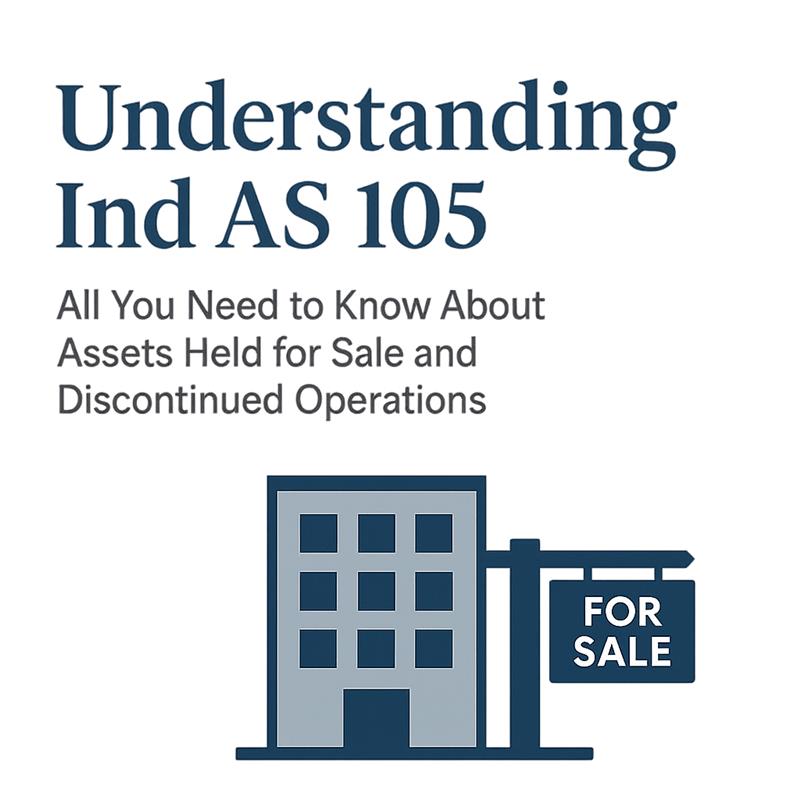03-Jun-2025 Understanding Ind AS 105- All You Need to Know About Assets Held for Sale and Discontinued Operations
#indas105 #auditcompliance #heldforsale #discontinuedoperations #assetclassificationInd AS 105 covers non-current assets held for sale, assets for distribution, and discontinued operations. These assets are measured at the lower of carrying value or fair value less costs, with depreciation stopped. Impairment losses are recognized, and gains reversed only up to prior losses. Separate disclosure in financials ensures better clarity and compliance.

In today’s dynamic business environment, companies often restructure, dispose of assets, or even shut down certain operations to remain competitive. But how are such changes reflected in the financial statements?
This is where Ind AS 105- Non-current Assets Held for Sale and Discontinued Operations- steps in.
Let’s break down this standard in simple terms to help us understand better its relevance and implications.
What is Ind AS 105?
Ind AS 105 governs the accounting treatment, measurement, and presentation of:
- a) Non-current assets (or disposal groups) held for sale,
- b) Non-current assets held for distribution to owners, and
- c) Discontinued operations.
The goal is to provide a transparent view of assets and operations that are no longer part of a company’s core business.
Key Definitions
- i) Non-Current Asset Held for Sale: An asset whose carrying amount will be recovered through a sale, not through continued use.
- ii) Disposal group : A group of assets to be disposed of, by sale or otherwise, together as a group in a single transaction, and liabilities directly associated with those assets that will be transferred in the transaction.
- iii) Held for Distribution to Owners: An asset or group of assets the company intends to distribute to shareholders
- iv) Discontinued Operation: A significant part of the business that has been sold or is held for sale/distribution and:
-
- a) Represents a major line of business/geographic area, or
- b) Is part of a coordinated disposal plan.
- c) Is a subsidiary acquired exclusively with a view to resale.
Criteria to Classify an Asset as ‘Held for Sale’
To classify a non-current asset (or disposal group) as "held for sale", the following criteria must be met:
- 1. Available for immediate sale in its present condition.
- 2. Sale is highly probable—expected within 12 months.
- 3. Management is committed to the plan.
- 4. An active program to locate a buyer is in place.
If the entity plans to distribute the asset to owners instead of selling it, similar criteria apply.
Delays Beyond One Year: Exception Allowed
Sometimes, events beyond the entity’s control may delay the sale. According to Ind AS 105:
An extension of the period to complete a sale beyond 12 months does not preclude ‘held for sale’ classification if the delay is due to circumstances beyond the entity’s control and there is sufficient evidence that the entity remains committed to the sale.
Examples of such circumstances include:
- i) Delays in regulatory approvals
- ii) Disruptions in market conditions
- iii) Litigation or unexpected legal issues
✅ In such cases, if certain conditions as mentioned in Ind AS 105 are met, the asset can continue to be classified as held for sale.
Measurement Principles
An asset (or disposal group) is measured at the lower of:
- i) Its carrying amount, and
- ii) Fair value less costs to sell or distribute
📌 Example: A company plans to sell a building with a carrying amount of ₹12 crores. The fair value less costs to sell is ₹11.2 crores. The asset will now be carried at ₹11.2 crores in the books.
Recognition of Impairment Losses and Reversals
- i) If the asset’s fair value less costs to sell/distribute is lower than its carrying amount, the difference is recognised as an impairment loss in the profit and loss account.
- ii) If, in a later period, fair value less costs to sell increases, a gain may be recognised, but only up to the amount of impairment loss previously recognised under this standard or Ind AS 36 (Impairment of Assets).
📌 Note: You cannot reverse beyond what was earlier impaired. This ensures gains are not overstated.
Depreciation and Amortisation
i) Once an asset is classified as held for sale or distribution, depreciation or amortisation must immediately stop.
This reflects that the asset is no longer in use and is now being recovered through sale or distribution.
Presentation in Financial Statements
- i) Non-current assets classified as held for sale must be presented separately from other assets.
- ii) Assets of a disposal group held for sale must also be separately disclosed.
- iii) Liabilities directly associated with a disposal group must be presented separately from other liabilities.
Assets and liabilities of a disposal group must not be offset or shown as a single combined amount.
- iv) Discontinued operations are disclosed separately in the P&L, improving transparency for users of the financial statements.
This clear separation improves the understandability and transparency of financial reports.
Real-World Scenarios
- i) Sale of a manufacturing division or warehouse.
- ii) Shutdown of a non-performing product line.
- iii) Distribution of assets (like shares in a subsidiary) to shareholders.
- iv) Planned disposal due to regulatory or strategic reasons.
Why Should You Care?
- i) Improves transparency and investor confidence.
- ii) Ensures compliance with Ind AS for audit and reporting.
- iii) Helps stakeholders assess continuing vs. discontinued performance.
✅ Quick Recap
- i) Assets are classified as held for sale/distribution if sale is highly probable.
- ii) Measure at lower of carrying amount and fair value less costs.
- iii) Impairment losses must be recognised; gains can be recognised, but only to the extent of earlier loss.
- iv) Depreciation stops once classified.
- v) Sales taking longer than 12 months can still retain held-for-sale status if commitment continues.
Should you require any assistance or clarification regarding these matters, please feel free to reach out to us at pooja@apdoshi.com
